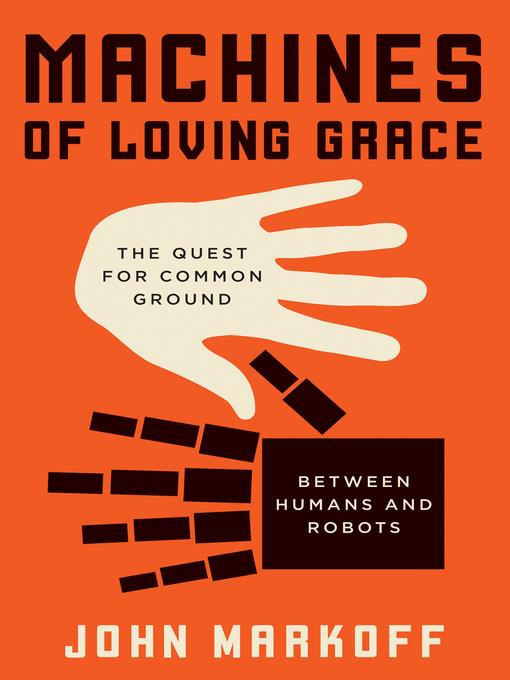
Machines of Loving Grace
The Quest for Common Ground Between Humans and Robots
کتاب های مرتبط
- اطلاعات
- نقد و بررسی
- دیدگاه کاربران
نقد و بررسی

June 8, 2015
“Loving grace” may be an alternative to relentless usurpation, according to this conflicted examination of the looming robot takeover. New York Times journalist Markoff (What the Dormouse Said: How the Sixties Counterculture Shaped the Personal Computer) considers the prospects of mass unemployment and human obsolescence from rapidly accelerating automation of labor, and suggests that we have a choice between the warring engineering strategies of “intelligence augmentation” that empowers the human mind and “artificial intelligence” that replaces it. (It’s the distinction, he contends, between Google’s user-friendly search engine and its user-sidelining driverless cars.) He follows this counterpoint through a detailed, engrossing history of robotics that takes in both the technical challenges—getting machines to identify shapes, navigate landscapes, heft boxes, parse legal documents, and perform surgery—and the design philosophies motivating researchers. Markoff’s lives-of-the-roboticists approach emphasizes “human decisions of engineers and scientists” in crafting automation that we can live with, yet this hopeful perspective can seem muddled and evasive: the advances he describes are clearly intended to marginalize and eliminate human labor, with little thought given to social consequences. This revealing look at profound technological and economic developments will unsettle anyone who has a job to lose. Photos.

June 15, 2015
An examination of philosophies undergirding the impending future of driverless cars and mobile robots. Longtime New York Times technology and business reporter Markoff (What the Dormouse Said: How the Sixties Counterculture Shaped the Personal Computer, 2005, etc.) focuses on technology's unexpected social impacts, discussing long-running divisions between artificial intelligence and "Intelligence Augmentation," as represented by innovations like Apple's Siri. Even now, "the separate disciplines of artificial intelligence and human-computer interaction rarely speak to one another." Beginning in the 1950s, this competitiveness incubated at MIT and Stanford. Early on, theoretical proponents of AI were marginalized, both by the perception of computers as massive business-oriented mainframes and by the practical successes of NASA, which "established a view of human-machine interaction that elevates human decision-making beyond the fallible machines of our mythology." Yet Markoff argues that several AI "bubbles" kept the obscure specialty alive, through the personal computer explosion of the 1980s and the dot-com developments of the '90s, so that it was primed for a comeback in the smartphone era, as evidenced by the ubiquity of Siri and Google, as well as sudden advancements in robotics. The author's overall argument is clear: that a synthesis is underway between future AI developments and the ubiquity of such technologies now. The author asserts that "programs like Siri...are beginning to make human-machine interactions in natural language seem routine." Markoff acknowledges but doesn't fully explore the likelihood of profound job losses, noting that as companies like Amazon encounter labor issues, "lights-out [robotic] warehouses are clearly on the horizon." The author illustrates his broader argument with real-world examples, ranging from Microsoft's failed interface device "Clippy" to Google's interest in both autonomous vehicles and robotics. Markoff offers a well-researched and controlled narrative, but his approach is jargon-heavy and too biographically focused on individual innovators in AI and computing, an approach used to better effect in What the Dormouse Said. Despite flaws, this should appeal as an earnest attempt to parse the future impact of these radical advances.
COPYRIGHT(2015) Kirkus Reviews, ALL RIGHTS RESERVED.

February 1, 2015
Technology and business reporter at the "New York Times" since 1988 and part of the team that won the 2013 Pulitzer Prize for Explanatory Reporting, Markoff tackles a worrisome question: Will robots make life better or just replace us? In response, he tracks back to two Pentagon-financed laboratories established in computing's early days, then forward to meet scientists, entrepreneurs, ethicists, hackers, and others and discuss today's scary new realities and the choices they involve.
Copyright 2015 Library Journal, LLC Used with permission.

August 1, 2015
Long before film director Stanley Kubrick introduced HAL, the duplicitous, computer-based artificial intelligence (AI) in 2001: A Space Odyssey, humans have felt understandably uneasy about letting machines get too smart for their creators' good. In this timely and thought-provoking contribution to the ongoing debate about whether machines will ultimately save us or supplant us, journalist Markoff takes a close look over the shoulders of AI technology's leading developers in today's global marketplace. He begins with a broad-ranging history of automation and the genesis of robotics from check-processing machines in the 1950s to the recent Google driverless car, along the way highlighting the achievements of the industry's most notable innovators, such as AI pioneer Charles Rosen and computer-mouse inventor Doug Engelbart. For Markoff, the opposing philosophies of those two pioneers represent the darker and lighter potentials of mankind's relationship to intelligent machines, with the author calling for the latter, a more benign path that puts human welfare first. A lucid must-read for anyone concerned about the future of robotics and computer-based intelligence.(Reprinted with permission of Booklist, copyright 2015, American Library Association.)

























دیدگاه کاربران